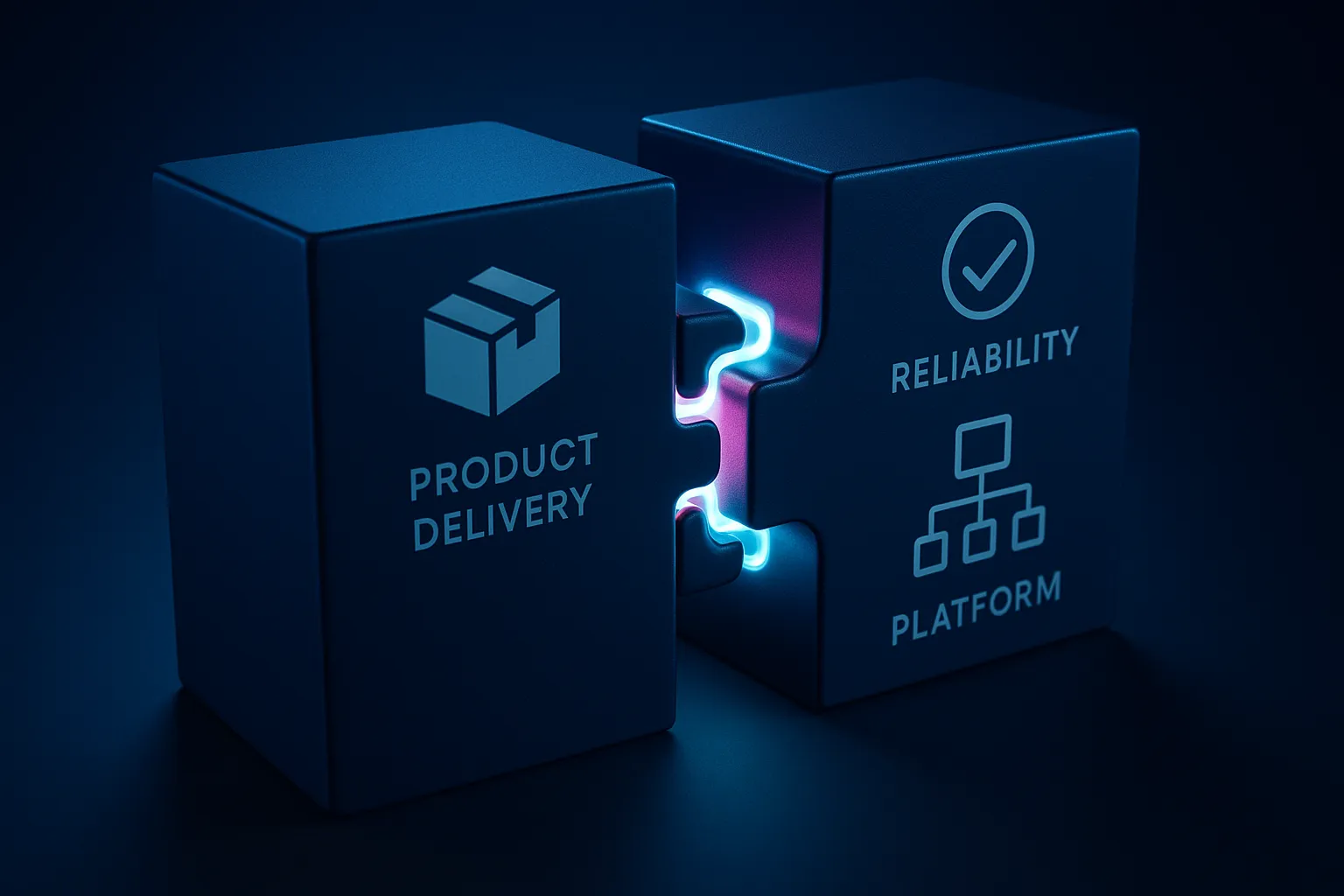The Hidden Gap Between Demo and Production
Where this started
I was halfway through drafting a different piece on SRE models and frameworks when a single sentence stopped me. I typed, “If we overspend the error budget, we slow releases,” and felt a tug I could not ignore. We already meter how fast we ship when reliability slips. So why do we not meter how much we serve when a new service is still immature?
The gap you can feel
That tug came with a memory. A few quarters back we had a sleek pilot that aced the demo. Health checks were green, latency looked pretty, confidence was high. The readiness meeting felt routine. Then we asked the boring questions. Where are the alerts for the critical path? What is the test coverage? Do we have a backup and a restore drill for the data it writes? Silence. Not refusal - just that fuzzy zone where everyone means well and nobody wants to slow momentum. We shipped a tiny slice anyway. Two days later the pager woke the room at 2 a.m. The fix was easy. The lesson was hard.
Out of that week came a joke that would not die: a “trust tax” on shaky new code. If a service could not show tests, alerts, runbooks, and basic data safety, it should pay the tax in the only currency that matters to customers - traffic. Give it a very small flow of real requests until it earns more. At the time it was a throwaway line meant to defuse tension. While writing about error budgets, it clicked for real.
The shift
In practice, an error budget is not just a report - it is a policy lever. When a team burns through its budget, many pause non-urgent releases to protect users and refocus on stability. The same spirit can guide how much a new service is allowed to serve. Today, that decision is mostly social. Production Readiness Reviews check for observability, runbooks, ownership, and disaster recovery, but they are still meetings that can be argued or rushed.
Rollouts already slice traffic by percent. Canaries and progressive delivery are excellent for catching regressions - you expose a small slice, observe, then widen. What those slices usually reflect, though, is change safety and human judgment, not the service’s earned operational maturity. That distinction matters for pilots that look good in a demo but are not ready to be trusted with real customers.
Here is the concrete pivot. If your availability target is 99.9%, you have roughly 43 minutes of budget in a 30 day month. Teams already plan change speed around that limit. Now add a parallel meter that governs traffic itself as the service proves it has tests, alert quality, on call ownership, and working backups. Call that Confidence Throughput and tie it to key maturity indicators. If you plan full capacity for the service at 100 RPS, but new product have just half of the check-boxes green - cap the throughput at 50 RPS.
Confidence Throughput starts conservative for a new pilot and widens as maturity improves. If signals degrade, the faucet narrows for a while. Managers can still override in daylight, with a paper trail. The point is not to slow innovation - it is to let services earn their traffic with evidence rather than optimism.
Try this
Add one line to your next pilot plan: Confidence Throughput allowed, followed by a conservative slice you are truly comfortable serving today. If writing that number makes you uneasy, you just found the first two maturity gaps to close.
How the Confidence Throughput Controls Traffic
Why a score, not a checklist
Checklists are binary and easy to argue with. A score is continuous and hard to ignore. Your confidence rises as the service proves it has the boring basics that protect customers - tests, alert quality, on call ownership, documented runbooks, security hygiene, and real backups that restore cleanly.
Core Formula
Confidence Throughput is the traffic cap the system enforces. The math stays simple:
Confidence Throughput = Base RPS × Trust Score.
Here, the
Trust Scoreis a signal of a service’s operational maturity between 0 and 1; andBase RPS- expected throughtput a fully trusted service should handle under normal conditions.
When a pilot is young, confidence is low, so the cap is a trickle. As maturity improves, the cap widens automatically. If signals degrade, the cap narrows for a while. You still keep canaries and manual judgment - you are just adding a quiet, “always-on” control that reflects earned trust.
What goes into the Trust Score
Keep the inputs few and observable on day one. Normalize each to a 0 to 1 range.
- CI maturity - meaningful tests exist and pass. Think coverage, pass rate, and reduced flake.
- Observability - SLOs defined, alert precision improving, dashboards cover the critical path.
- Operations - someone is on call, runbooks exist, dependencies are tracked, docs are current.
- Security - known vulnerabilities are addressed by severity, images and infra are scanned.
- Resilience - data can survive mistakes. Start with Backup Success Rate and graduate to Restore Test Pass Rate and RPO compliance as you automate.
Use a simple product for the first version: Trust Score = CI × Observability × Operations × Security × Resilience. The weakest factor limits the whole - which is exactly the point.
Make it hard to game, easy to live with
- Independent sources - pull inputs from CI, monitoring, backup, and security systems of record, not from app flags.
- Rolling windows - compute inputs over a recent period so one good day does not spike the score.
- Cool downs - slow the rate of change so the cap does not flap hour to hour.
- Minimums and floors - set sensible lower bounds so a transient blip does not zero traffic.
- Escape hatch - allow temporary overrides in daylight with a written reason.
Quick recipe to try
- Publish the Trust Score as a metric next to latency and error rate. Show the five factor components so teams see what to fix next.
- Apply the cap at the edge or mesh: compute Trust Score at set indervals (i.e. hourly) and set a per service rate limit to Base RPS × Trust Score.
- Add Resilience early: surface Backup Success Rate and a simple weekly restore drill result. Even a basic restore to a scratch environment is enough to start.
- Show the path: in the service’s README, list three concrete steps that would raise Trust next. Keep them small and verifiable.
This is not about slowing teams. It is about earning traffic with evidence. Confidence Throughput gives you a dial that turns itself as the service matures - and turns itself down when the signals say it should.
Pilot That Earns Its Way Into Production
Key term: Feature toggle - a switch that controls who can see and use a capability at runtime.
Build, deploy, get traffic on day one
The moment the first endpoint exists, we deploy it behind a feature toggle. Confidence Throughput reads the early Trust Score and sets a tiny faucet. Requests start flowing immediately - not to the world, but enough for signals and learning. Think of three lanes you can open from the start:
- Synthetic lane - CI and a lightweight job send real HTTP calls through the edge, exercising the same path customers would. Responses are checked and thrown away. You get burn-in data without user risk.
- Inside lane - engineers and support toggle the feature on for themselves. Real browsers and mobile clients hit the service in normal workflows. Confidence Throughput keeps volume low while Trust is still growing.
- Opt-in lane - a very small external cohort can be invited when you want feedback from real users. The toggle grants visibility. Confidence Throughput governs how much traffic the service is allowed to accept overall.
Synthetic proves the path, Inside proves real workflows, Opt-in proves customer value.
Feature toggles decide who can see it. Confidence Throughput decides how much the service may handle. That separation lets teams move fast without betting the company.
How the loop evolves
Early Trust is usually low, so the faucet is a trickle. You write a few meaningful tests, wire one SLO on the critical path, and tune a noisy alert. Someone claims on call and drafts a short runbook. Backups start running and a simple restore drill proves the data comes back clean. Each step nudges Trust up. The faucet opens by itself. You do not ask permission in a meeting - you show the score and earn more traffic.
As confidence builds, the toggle rings expand. Internal stays on. The opt-in cohort grows from dozens to a few hundred. If a dependency hiccups or a scan flags a high severity issue, Trust dips and the faucet narrows for a while. Nobody scrambles to convene a war room. You fix the thing that moved the score and traffic resumes its rise with a cool down so it does not flap.
Where teams get the most value
- Faster learning without drama - you can watch real traces and logs within hours of first code, not weeks after a big reveal.
- Clear next actions - the Trust Score shows exactly which factor limits you. Teams do the boring basics because the meter rewards them.
- Safer invitations - toggles let you choose visibility, Confidence Throughput limits volume. You can run a public beta and still cap blast radius.
What to watch for
- Hidden scale risks - a small faucet will not surface some bottlenecks. Keep a separate synthetic job that periodically pushes toward Base RPS in a quiet window.
- Starving critical flows - do not apply the cap to safety or compliance paths. Declare and document exceptions in daylight.
- Metric gaming - source inputs from CI, monitoring, backup, and security systems of record, not self reported flags.
- Handle excess traffic - decide whether to queue briefly, shed with 429, or route to fallback when the cap is reached.
Ready to start?
Add a single checkbox to your branch deploy pipeline: Enable internal toggle and start Confidence Throughput at a trickle. It takes one commit, and you will have real signals the same day you write the first line.
Confidence Beyond Code
Empowering teams
Real value of this approach lies in giving product teams the way to production they can control and impact directly.
- Launch without a permission queue - ship a small pilot the moment it is useful. No standing in line for a weekly gate.
- Own your path to bigger audiences - the Trust Score makes next actions obvious, so teams raise their reach by shipping tests, alerts, runbooks, and resilience work without waiting for sign off.
- Clear finish lines, no moving goalposts - thresholds to widen traffic are visible on the dashboard, not hidden in a slide deck.
- Less status theater - one card replaces long readiness docs. Leaders and engineers stare at the same signal.
- Safer experiments from day one - internal, synthetic, and small opt in cohorts are available immediately, so learning starts early while risk stays contained.
- Fewer handoffs - inputs come from CI, monitoring, backups, and security systems, so ops and platform teams contribute automatically while product teams keep ownership.
- Predictable ramps instead of last minute drama - traffic grows as the score improves, with smooth cool downs if signals dip.
- Quieter nights - better alert quality and resilience reduce noisy pages, and the cap tightens when things drift until fixes land.
- Better retros and faster fixes - when the dial moves, the log shows which signal did it, turning blame into a concrete to do list.
- Higher morale, real accountability - progress is earned and visible, gatekeeping fades, and teams feel trusted to do the right work.
Resilience beyond backups
Backups matter, but resilience is bigger. Keep Backup Success Rate and Restore Test Pass Rate, then expand the Resilience factor so teams earn more traffic with real safety, not vibes.
- Chaos experiment pass rate for a few critical paths.
- Dependency health for key upstreams that can hurt you.
- Region evacuation or failover drill outcome on a simple cadence.
- Runbook quality check - first three incident steps tested by the on call.
Each signal is binary to start, then matures over time. Wire them once, reuse them across services, and you turn resilience into a habit that quietly lifts the Trust Score.
Apply the dial to marketing and paid traffic
The same pattern works outside code. While feature toggles choose who sees an offer, let the dial meter volume in two places:
- Allowed traffic = Base RPS × Trust Score
- Allowed ad spend = Base ad budget × Trust Score
To guide scale without spreadsheets, pair the Trust Score with the LTV/CAC ratio and use this simple 2×2 matrix:
| LTV/CAC low | LTV/CAC high | |
|---|---|---|
| Trust high | Efficiency Problem: improve unit economics before increasing spend. | Cash Cow: The service is mature and profitable. Allocate the full marketing budget to scale. |
| Trust low | Problem Child: The service is both immature and unprofitable. This is the worst-case scenario. | Sleeping Giant: Your marketing is working, and the customers you acquire are valuable. Invest in Trust Score, then scale marketing. |
This keeps teams focused: earn trust to unlock reach, and keep spend honest with a plain signal leaders recognize.
Wrap up - aligned freedom, clear guardrails
Key term: Guardrail override - a documented, temporary bypass with a reason and an expiry.
Show one shared card on the dashboard: Trust Score, Allowed traffic, Allowed spend, plus one next best action to raise Trust this week. Overrides exist for the rare moments when time to market equals dollars - use them in daylight, with auto expiry and a visible log. The big idea is simple: one dial, many surfaces. It starts in engineering, extends to marketing, and gives teams more autonomy while keeping customers - and budgets - safe.



